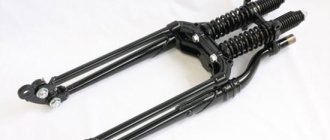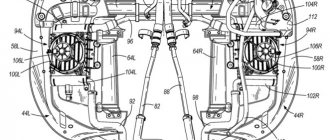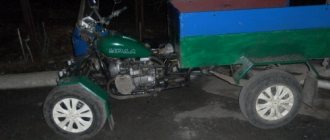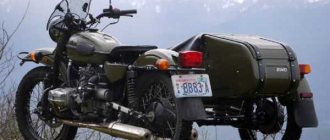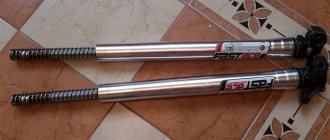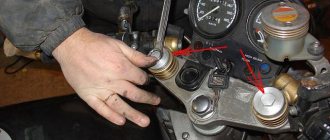How much oil to pour into gasoline in Minsk?
Fill with gasoline in a ratio of 1:20. That is, for 20 liters of gasoline - 1 liter of oil.
Interesting materials:
Can you eat green cabbage? Is it possible to eat apple seeds? Is it possible to eat fried fish while dieting? Is it possible to eat live grasshoppers? Is it possible to eat scrambled eggs every day? Is it possible to eat oatmeal cookies every day? Is it possible to eat bread at night? Is it possible to go to the bathhouse immediately after eating? Is it possible to feed a sterilized cat human food? Is it possible to feed a cat homemade food?
Working conditions of a motorcycle shock absorber fork
The front fork is two long tubular pieces that hold the front wheel to the motorcycle. These parts move up and down to compensate for unevenness in the road surface.
Unlike a car shock absorber, the spring assembly allows the fork leg to compress and then spring back, resulting in a better ride and improved traction. Each of the front fork tubes for most motorcycles contains a spring and oil. Back in the middle of the last century, fork legs were just a spring inside a pipe. When the spring was compressed by the impacts, the front of the motorcycle bounced.
After the development of the damping system, this bouncing motion became much smoother. However, to soften shock impacts, the system must contain an incompressible fluid that can easily withstand shock loads - fork oil. The most common design is one where inside each shock absorber fork leg there is a tube with holes and chambers that control the movement of oil.
How to choose fork oil?
First of all, by its viscosity. As is known, kinematic viscosity is measured in centistokes (cSt), and represents the speed of fluid flow through a conventional tube of a certain cross-section. In practice, the dimension mm2/s is more often used. In relation to fork oils, the standards of the American Society of Automotive Engineering (SAE) apply, which relate viscosity values at a certain temperature (usually 40 °C) to the density and weight of the product. Weight in English weight; From the initial letter of this word the designations of fork oil brands are formed. So, when considering fork oils for motorcycles of brands 5W, 10W, 15 W, 20W and so on, you should remember that, for example, 10W class oil corresponds to a product with a nominal viscosity of about 10 mm2/s.
Fork oil weight is determined by an industry standard for hydraulic systems called Saybolt Seconds Universal (SSU). Unfortunately, the voluntarism of the main manufacturers often leads to confusion among the labeling of fork oils. The following correspondence of viscosity parameters was experimentally established:
| Marking | Actual viscosity value, mm2/s at 40 °C, according to ASTM D 445 for brand products | |||
| RockShox | Liqui Moly | Motul | Motorex Racing Fork Oil | |
| 5W | 16,1 | 17,2 | 18 | 15,2 |
| 10W | 33 | 29,6 | 36 | 32 |
| 15W | 43,8 | 43,9 | 57 | 46 |
| 20W | — | — | 77,9 | 68 |
How to replace fork oil?
To calibrate the oil, a much more sensitive viscosity calibration scale is used, so in practice you can get a conditional 7.5W or 8W “for yourself” by mixing ordinary industrial oils in the required proportions. For the performance of a product under specific operating conditions, it is not the viscosity value itself that is important, but the so-called viscosity index. It is usually indicated on the Saybolt Seconds Universal (SSU) scale at 100°C. Let's assume that the numbers indicated on the container read as 85/150. This means that the SSU value of the oil at 100 ºC is 85. The viscosity of the oil is then measured at 40 ºC. The second number - 150 - is a value showing the difference in flow between the two temperatures, which determines the declared viscosity index.
What does this have to do with motorcycle forks? The friction created by sliding metal parts and oil moving back and forth increases the temperature inside the assembly. The more constant the oil weight remains, the less likely it is that the fork damping will change.
Thus, it is quite possible to replace fork oil with industrial oil, combining its brands according to the operating conditions of your motorcycle.
With certain reservations, this principle can be used for other vehicles (with the exception of racing motorcycles).
Rear shock absorber repair
To eliminate defects in the rear shock absorbers of the Izh 6.113-05 motorcycle, as well as to change the oil, their disassembly is required.
We put the motorcycle on the center stand and remove the shock absorbers (if you need to remove both shock absorbers at once, you must remember to put a support under the pendulum so that it does not fall).
We compress the spring with special clamps (I tried to compress the spring with a car puller, but it didn’t work because their ears are too thick). But you can do without them; to do this, take a gas key and insert it between the coils of the spring. Let's step on the gas. the key with all its weight, the spring is compressed, and meanwhile your partner removes the two supporting half-rings.
This is how we place the key and press on it from above. We take out the supporting half rings.
Metal-ceramic crowns Karmen Med. Cooperation . International logistics.
We take out the spring, plastic cup and spring preload adjuster.
We clamp the lower tip in a vice and use a 27 wrench to unscrew the nut of the seal housing. In order to remove the rod completely, you need to pull it towards you with force (see photo). But be careful as there is still oil in the shock absorber.
Use a 27 wrench to unscrew the nut. Pull the rod towards you.....
We inspect the rod, pay attention to the working edge of the oil seal. To replace the rubber bands, you need to unscrew the rod nut (after holding it by the upper tip in a vice) and remove the piston with valves, seal housing, oil seal and rubber buffer from the rod.
This is what the stock looks like with all the details.
After washing all parts in kerosene or gasoline, and replacing worn parts. We assemble the shock absorber, not forgetting to fill in 0.075 liters. spindle oil AU or liquid MGP-10 (this is according to the instructions, but I would not recommend it, since these days you cannot find these oils with the proper quality), it is better to find an analogue of these oils from foreign manufacturers.
Assemble the shock absorber with clean hands on a clean table so that not a single grain of sand gets inside; only this can guarantee long and trouble-free operation of this unit.
Source
motorcycles and motorcyclists
I was already a little fed up with the knocking noise in the front fork and I decided to get rid of it after all. I took it apart and washed everything. To get rid of the knocking I decided to install a rebound spring. I don’t know what it’s from, but it was long and it was enough for me to make 4 pieces. I screwed it onto a fork like rings from keychains are screwed onto keys. I trimmed it on the fork using pliers. I measured the length of the resulting spring with a caliper and cut the main springs exactly the same amount. IMPORTANT! measure the length of the spring after you put the spring on the rod and not before. Since the spring after installation is slightly deformed and the length may not match.
My fork seals were leaking and, having learned from past mistakes, I did not change the fork bushings; there was a slight play in them, but I think they still fit. Replaced the fork cups and seals. I decided to assemble without fork covers. I like it better this way. I polished the fork tubes because they were all rusty. I had to make a new headlight mount, but more on that in another blog.
I poured 150 ml of fresh, clean oil into each feather as required. After the first trip of joy, I had whole pants. No matter how much I drove over bumps, no matter how much I tried to pull the fork towards myself, I never heard this nasty knock.
Telescopic fork - removal, disassembly, assembly and installation, replacement of shock absorber fluid
The telescopic fork has to be removed and disassembled when there are knocking noises during movement, deterioration of vibration damping, leaks, as well as a planned replacement of shock absorber fluid.
1. Remove the front wheel with the brake drum cover.
2. Disconnect the front wheel mud shield from the left sliding pipe of the fork.
3. 14 mm
loosen the nut of the steering column upper cross member.
4. 27 mm
Unscrew the shock absorber plug a few turns.
5. 17 mm
loosen the tightening of the nut of the coupling bolt of the lower bridge (traverse).
6. Using light blows of a hammer through a wooden spacer, knock out the supporting pipe from the upper and lower traverses.
7. Remove the fork leg from the lower crossbar.
Similarly, remove the second fork leg.
Install the plug in reverse order.
1. Remove the fork leg from the motorcycle (see above).
Changing the oil in a motorcycle fork
The most common front fork is the telescopic design. The so-called “telescopes” are found on all Soviet-made boxer motorcycles and appeared back in the distant 30s of the last century. During the period of constant improvement and refinement of the design, many manufacturers went their own way, making significant changes to the seemingly simple design. Changing the oil in the front fork of a motorcycle must take into account all the design features and operating principles of each specific vehicle model.
The most widely produced motorcycles are those with a fork design that uses two tubes. One is steel, with a larger diameter. The second is chrome plated, which is called the fork leg. Moving up and down with the steering wheel, there is a hydraulic valve located inside for each side. The structure is strengthened by a powerful spring. Protection is achieved by installing anthers and seals. Changing the oil in the front fork of a motorcycle is done by pouring fluid directly into the cavity of a smaller diameter tube.
As a result of active movement, reacting to each bump or hole, the oil is the first to become unusable. This happens because all kinds of debris and small metal shavings begin to get into the liquid due to the friction of metal parts. After just a year of active riding, a change in the behavior of the fork may be observed. Following the oil, the anthers and seals also deteriorate. They begin to let in water and all kinds of pollutants. The oil absorbs them and ceases to perform its function.
Changing the oil in a motorcycle fork can be simple if the manufacturer provides holes for draining and filling oil, but it can be complicated when a total repair or restoration of some elements is necessary.
Start of renovation
Before starting repairs, place the motorcycle on a comfortable and reliable stand, so that the front wheel is free. Next you will need to remove the wheel and disconnect it from the brake mechanism. In some cases, it is also necessary to remove the wing or rudder.
You should start by “undermining” the plugs of the feathers. Not by unscrewing, but by changing the position of the cover by a quarter turn. Corks are always made with decorative processing or chrome plated. If you don’t have a reliable and clearly sized key on hand, you shouldn’t injure the plugs.
A slight slippage or licking of the edges will immediately ruin the attractive appearance. Some craftsmen use fabric or thin rubber as a gasket. This method cannot prevent the appearance of scratches, even if you try very hard.
A closed plug will not only protect the cylinders from dirt, but will also prevent injury from a fired, tense steel spring. After loosening the traverse bolts, you need to smoothly remove the fork. Before this procedure, you should have a container prepared to remove used oil from the fork. Turn the fork over and drain the oil from the feathers. Judging by the color and consistency, it becomes clear why the fork was cottony or too hard.
Sequencing
In order to understand what kind of oil to pour into the front fork of a motorcycle, read the manual or instructions for your vehicle. This information is very important because oil can have different densities. Therefore, the denser the oil, the stiffer the fork will behave. A rigid fork transmits more vibration, making movement less comfortable. However, the main advantage is the absence of strong shock and deformation of the fork if you catch a hole at high speed.
It will be necessary to very accurately fill the oil to a certain level. There are two ways to do this correctly:
- When removing the fork, measure the former level - this only works if there are no oil leaks or deformation of the glasses;
- Fill exactly the amount indicated in the manual.
A plug that is too airy or overfilled will not function properly. In the first case, the movement of the motorcycle will fail, in the second, the reaction to unevenness will be too noticeable. It is the oil level that determines the volume of the air gap, which interacts with the road. For expensive and sports motorcycles, it is important to know what kind of oil to pour into the front fork of the motorcycle. It comes in viscosities of 2.5, 3.5 and 7.5 W. It is noteworthy that by mixing two oils of different viscosities, you can obtain an average viscosity.
Remaining oil is removed by moving the piston up and down. If you see a significant excess of service life based on the color and contamination of the drained oil, you need to wash the internal surfaces with kerosene. Having filled in new oil to the previously determined level, you can begin reassembly.
Important! If you have already disassembled the fork, immediately check all the elements for scuffs and damage. A caring motorcyclist immediately changes all boots and seals to prevent leakage in the future, so immediately take care of the availability of spare parts. Particular attention should be paid to inspecting the bushings, which should secure the fork and not interfere with the operation of the seals. Often, a broken bushing gives freedom to oil seals and anthers, which quickly wear out. An inexperienced motorcycle owner changes boots regularly, but does not eliminate the cause of their wear.
Checking work
The most adequate assessment of the work done after reassembly is a ride on the updated motorcycle. It’s not for nothing that they say that after changing the oil, a motorcyclist ends up with a completely different piece of equipment in his hands. The fork should be elastic, stable, not sag or be too stiff.
We recommend reading:
(1 ratings, average: 5.00 out of 5)
motoholder.ru
How to fill oil into Izh Planet shock absorbers
Excerpts from the operating manual for IZH Planet 5-01.
1. Gas tank - 18 l. Gasoline A-76, AI-93, AI-95 (for motorcycles with a separate engine lubrication system) or gasoline A-76, AI-93 mixed with oils in a ratio of 25:1: motor automobile for M-8V carburetor engines (automatic *), motor oils for automobile and tractor diesel engines M-10B2 (diesel*), aviation oils MS-14, MS-20 or oils for two-stroke engines SAE 30, SAE 40, SAE 50 at air temperatures down to minus 5 °C and SAE 15W, SAE 20W - below minus 5 °C or with MGD-14M oil in a ratio of 50:1.
2. Gearbox - 1.0 l. Oils M-8B, M-10B2 or oils for engines SAE 30, SAE 40, SAE 50 at air temperatures up to minus 5 °C and SAE 20W, SAE 15W - below minus 5 °C.
3. Engine (capacity in the left crankcase cover) - 0.75 l (PCC cover)*. Oils M-8V, M-10V2, MS-14, MS-20, MGD-14M or oils for two-stroke engines SAE 30, SAE 40, SAE 50 at air temperatures up to minus 5 ° C and SAE 15W, SAE 20W - below minus 5 °C.
4. Air purifier - 0.15 l (both standard and increased volume)*. Oils M-8V, M-10V2, MS-14, MS-20, MGD-14M or oils for two-stroke engines SAE 30, SAE 40, SAE 50 at air temperatures up to minus 5 ° C and SAE 15W, SAE 20W - below minus 5 °C.
